Social tenants in Scotland 2016
Overview of social tenants and social rented housing in Scotland for 2016, covering information on stock, households, housing flows, rents and income.
Section 2: Number of Social Tenants and Social Housing Stock Provision
2.1 Number of people in social housing and stock levels
Similar to the previous two years, social rented housing in Scotland in 2016 was provided by 26 of the 32 local authorities who owned and ran local authority housing stock, along with 161 housing associations who owned and ran housing association stock. Of the 32 local authorities, 6 did not directly manage social housing stock due to previous stock transfers to housing associations across the years 2003 to 2007, however they still provided some housing services such as homelessness support. [2]
There were an estimated 1.17 million people living social rented housing in 2016, a similar figure to the estimated 1.14 million people in the previous year, but a decrease of 22% from the estimated 1.49 million people in 1999.
Social housing stock totalled 594,458 units in 2016, a slight decrease of 594 (0.1%) homes from 595,052 units in 2015, and an 18% decrease on the 726,283 units in 1999.
Chart 2.1: Estimated Number of People in Social Housing and Stock Levels, 1999 to 2016
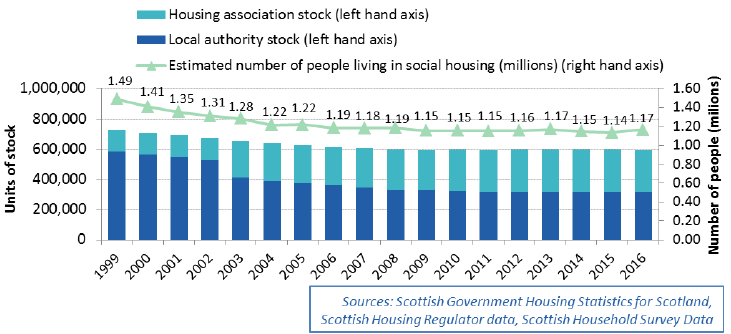
From 1999 to 2009 the number of people living in social housing in Scotland fell by 23% from an estimated 1.49 million people to 1.15 million people. During this time period the amount of social housing stock dropped by 18% from 726,300 to 594,100. The drop in the number of people was greater than the drop in the stock because the average size of a social rented household decreased from 2.1 people in 1999 to 2.0 people in 2009.
Since 2009 social housing stock levels have remained broadly stable at between around 594,000 and 597,000 units per year between 2009 and 2016. Between 2009 and 2016, the number of people in social housing has been between 1.14 million and 1.17 million each year. The estimated 1.17 million people living in social housing in 2016 is 22% lower than the estimated number in 1999 (1.49 million).
The drop in levels of social housing stock between 1999 and 2009 can be attributed to the number of sales (i.e. Right to Buy sales) and demolitions being higher than the number of units of new supply achieved through new build completions and other acquisitions of stock. Social housing stock levels have been broadly stable between 2009 and 2016, which suggests that the number of units demolished and sold under Right to Buy each year across this time period has largely been balanced out by new supply provision.
Stock transfers in 6 local authority areas between 2003 and 2007 saw dwellings being transferred from local authority control to housing associations. Glasgow, Dumfries and Galloway and Scottish Borders transferred their stock in 2003, followed by Argyll and Bute and Na h-Eileanan Siar in 2006, and Inverclyde in 2007.
There was an average of 2.0 people per social household in 2016, an average of 1.6 adults and 0.4 children. These figures are similar to the previous year, but a decrease from the 2.1 people per social household in 1999. The drop from 1999 to 2015 has been largely due to a fall in the average number of children per household from 0.5 in 1999 to 0.4 in 2016.
Chart 2.2: Average number of people per household, social rented households
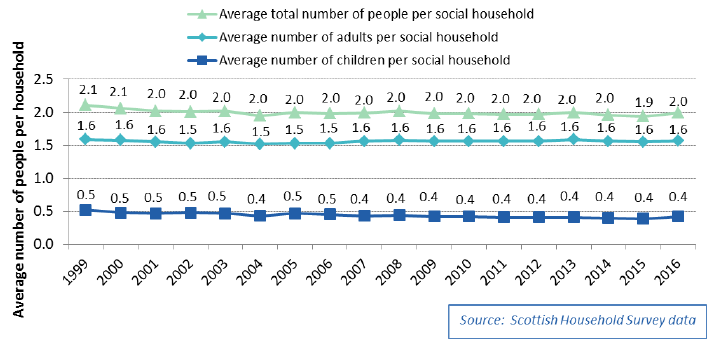
Table 2.1: Social housing stock, average number of people per household, and estimated number of people in social housing, 1999 to 2016
| Year | 1999 | 2000 | 2001 | 2002 | 2003 | 2004 |
|---|---|---|---|---|---|---|
| Local authority stock as at March | 584,375 | 564,783 | 546,962 | 527,454 | 414,256 | 388,160 |
| Housing association stock as at March | 127,894 | 130,925 | 138,709 | 143,188 | 238,472 | 251,074 |
| Total social housing stock as at March | 726,283 | 707,267 | 691,524 | 673,819 | 654,730 | 640,392 |
| Vacant local authority stock as at March | 19,843 | 21,530 | 22,062 | 20,746 | 16,474 | 14,399 |
| Estimated vacant housing ssociation stock | 1,212 | 1,241 | 1,315 | 1,357 | 2,260 | 2,379 |
| Total estimated vacant social stock as at March | 21,055 | 22,771 | 23,377 | 22,103 | 18,734 | 16,778 |
| Estimated occupied social stock as at March | 705,228 | 684,496 | 668,147 | 651,716 | 635,996 | 623,614 |
| Average number of adults per social household | 1.6 | 1.6 | 1.6 | 1.5 | 1.6 | 1.5 |
| Average number of children per social household | 0.5 | 0.5 | 0.5 | 0.5 | 0.5 | 0.4 |
| Average total number of people per social household | 2.1 | 2.1 | 2.0 | 2.0 | 2.0 | 2.0 |
| Estimated number of adults in social housing (millions) | 1.12 | 1.08 | 1.04 | 1.00 | 0.99 | 0.95 |
| Estimated number of children in social housing (millions) | 0.37 | 0.33 | 0.31 | 0.31 | 0.30 | 0.27 |
| Estimated total number of people in social housing (millions) | 1.49 | 1.41 | 1.35 | 1.31 | 1.28 | 1.22 |
| Year | 2005 | 2006 | 2007 | 2008 | 2009 | 2010 |
| Local authority stock as at March | 373,554 | 361,876 | 345,744 | 329,524 | 325,648 | 323,138 |
| Housing association stock as at March | 251,475 | 251,100 | 261,447 | 269,398 | 268,427 | 272,401 |
| Total social housing stock as at March | 625,508 | 612,976 | 607,191 | 598,922 | 594,075 | 595,539 |
| Local authority vacant stock as at March | 14,050 | 12,060 | 10,289 | 9,269 | 9,120 | 9,756 |
| Estimated vacant housing ssociation stock | 2,383 | 2,380 | 2,478 | 2,553 | 2,544 | 2,710 |
| Total estimated vacant social stock as at March | 16,433 | 14,440 | 12,767 | 11,822 | 11,664 | 12,466 |
| Estimated occupied social stock as at March | 609,075 | 598,536 | 594,424 | 587,100 | 582,411 | 583,073 |
| Average number of adults per social household | 1.5 | 1.5 | 1.6 | 1.6 | 1.6 | 1.6 |
| Average number of children per social household | 0.5 | 0.5 | 0.4 | 0.4 | 0.4 | 0.4 |
| Average total number of people per social household | 2.0 | 2.0 | 2.0 | 2.0 | 2.0 | 2.0 |
| Estimated number of adults in social housing (millions) | 0.93 | 0.92 | 0.93 | 0.93 | 0.91 | 0.91 |
| Estimated number of children in social housing (millions) | 0.29 | 0.27 | 0.26 | 0.26 | 0.24 | 0.24 |
| Estimated total number of people in social housing (millions) | 1.22 | 1.19 | 1.18 | 1.19 | 1.15 | 1.15 |
| Year | 2011 | 2012 | 2013 | 2014 | 2015 | 2016 |
| Local authority stock as at March | 319,878 | 319,384 | 318,160 | 317,572 | 317,005 | 316,553 |
| Housing association stock as at March | 274,996 | 277,484 | 277,379 | 277,555 | 278,047 | 277,905 |
| Total social housing stock as at March | 594,874 | 596,868 | 595,539 | 595,127 | 595,052 | 594,458 |
| Local authority vacant stock as at March | 7,667 | 7,847 | 7,013 | 6,556 | 6,515 | 6,181 |
| Estimated vacant housing ssociation stock | 2,605 | 2,576 | 2,855 | 2,470 | 2,676 | 2,453 |
| Total estimated vacant social stock as at March | 10,272 | 10,423 | 9,868 | 9,026 | 9,191 | 8,634 |
| Estimated occupied social stock as at March | 584,602 | 586,445 | 585,671 | 586,101 | 585,861 | 585,824 |
| Average number of adults per social household | 1.6 | 1.6 | 1.6 | 1.6 | 1.6 | 1.6 |
| Average number of children per social household | 0.4 | 0.4 | 0.4 | 0.4 | 0.4 | 0.4 |
| Average total number of people per social household | 2.0 | 2.0 | 2.0 | 2.0 | 1.9 | 2.0 |
| Estimated number of adults in social housing (millions) | 0.91 | 0.91 | 0.93 | 0.91 | 0.91 | 0.92 |
| Estimated number of children in social housing (millions) | 0.24 | 0.24 | 0.24 | 0.23 | 0.23 | 0.25 |
| Estimated total number of people in social housing (millions) | 1.15 | 1.16 | 1.17 | 1.15 | 1.14 | 1.17 |
Sources: Scottish Government Housing Statistics for Scotland, Scottish Housing Regulator data, Scottish Household Survey data
Notes: Vacant housing association stock has been estimated for the years 1999 to 2009 by applying a percentage figure of 0.95% to the total stock figures for each year, a proportion based on the vacant normal letting stock figures available across the years 2010 to 2016.
The number of people in social housing has been estimated by applying the average number of people per household to the number of social stock units after netting off vacant stock
Further detail on public sector stock figures is available from the ‘Housing Statistics for Scotland 2017: Key Trends Summary’ [3] and associated web tables [4] .
The introduction of Right to Buy legislation in 1979 had a substantial impact on the profile of Scottish housing, with nearly half a million social housing properties being sold from 1979 to 2016. The provision to end Right to Buy with a two year notice period was included in the Housing (Scotland) Act which received Royal Assent on 1 August 2014, and the scheme subsequently closed to all new applicants on 31 July 2016.
Further detail on Right to Buy sales statistics and other factors associated with social housing stock levels, such as new build housing by local authorities and housing associations, is published in Quarterly Housing Statistics updates, available from the Scottish Government Housing Statistics webpages [5] .
2.2 Local authorities and housing associations – stock levels and operating areas
Table 2.2 below shows the number and percentage of local authorities and housing associations by the size of their stock, for each year from 2014 to 2016 (March for each year) while Chart 2.3 illustrates the trends. It can be seen that local authorities generally had a larger size of stock, with almost two-thirds (65%) of the 26 local authorities having stock levels between 5,001 and 20,000 homes, whilst more than eight in ten (83%) housing associations had stock levels of 2,500 homes or less. There has been little change to this pattern over time.
Table 2.2: Social housing providers by size of stock, 2014 to 2016
| 2014 | 2015 | 2016 | Percentages (2016 based) | |||||
|---|---|---|---|---|---|---|---|---|
| Stock size | Local Authorities | Housing Associations | Local Authorities | Housing Associations | Local Authorities | Housing Associations | Local Authorities | Housing Associations |
| 0 to 1,000 | 1 | 87 | 1 | 88 | 1 | 87 | 4% | 54% |
| Over 1,000 to 2,500 | 1 | 46 | 1 | 46 | 1 | 47 | 4% | 29% |
| Over 2,500 to 5,000 | 3 | 19 | 3 | 18 | 3 | 18 | 12% | 11% |
| Over 5,000 to 10,000 | 7 | 7 | 7 | 8 | 7 | 7 | 27% | 4% |
| Over 10,000 to 20,000 | 10 | 1 | 10 | 1 | 10 | 1 | 38% | 1% |
| Over 20,000 | 4 | 2 | 4 | 1 | 4 | 1 | 15% | 1% |
Sources: Scottish Government Housing Statistics for Scotland and Scottish Housing Regulator Stock data
Chart 2.3: Social housing providers by size of stock, 2014 to 2016
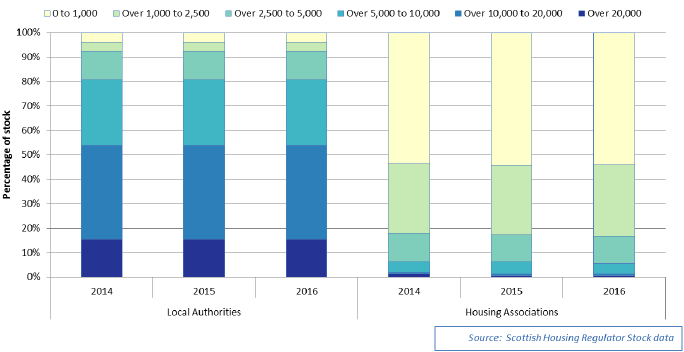
Whilst local authorities operate within each of their own specific areas, housing associations can operate across different local authority areas. Table 2.3 below shows the number and percentage of housing associations by the number of different local authority areas that they operate, for 2014, 2015, and 2016 (March for each year). It can be seen that in 2016, 71% of housing associations operated in a single local authority area; 19% operated in 2 to 5 different local authority areas, whilst the remaining 10% operated across 6 or more local authority areas. There has been little change in percentages over the 3 year period.
Table 2.3: Number of Housing Association operating areas, 2014 to 2016
| 2014 | 2015 | 2016 | |||||
|---|---|---|---|---|---|---|---|
| Number of local authorities operated in | % | Number of local authorities operated in | % | Number of local authorities operated in | % | ||
| 1 | 113 | 70% | 115 | 72% | 115 | 71% | |
| 2 to 5 | 31 | 19% | 29 | 18% | 30 | 19% | |
| 6 to 10 | 7 | 4% | 7 | 4% | 6 | 4% | |
| 11 to 20 | 4 | 2% | 4 | 3% | 4 | 2% | |
| 21 or more | 6 | 4% | 5 | 3% | 6 | 4% | |
Source: Scottish Housing Regulator Stock Data
Note: Landlords with zero self-contained units in a local authority were excluded.
Table 2.4 below shows the amount of social rented housing stock in each local authority area as at March 2016, split by local authority and housing association providers (tables for 2015 and 2014 are available through the excel web tables). Across all of these tables, the 6 stock transfer authorities have no local authority owned stock. For the other 26 local authorities, local authority stock as a proportion of all social stock varied from 53% in the City of Edinburgh to 83% in Aberdeen City in 2016. At a Scotland level 53% of social rented housing stock was owned by local authority providers, with 47% being owned by housing association providers.
Table 2.4: Social housing stock in each local authority area, as at 31 March 2016
| Local Authority Area | Local authority stock | Housing association stock | Total social housing stock | % of stock that is Local authority | % of stock that is housing association | Total number of dwellings | Social stock as a proportion of all dwellings |
|---|---|---|---|---|---|---|---|
| Aberdeen City | 22,220 | 4,582 | 26,802 | 83% | 17% | 114,657 | 23% |
| Aberdeenshire | 12,874 | 4,641 | 17,515 | 74% | 26% | 115,822 | 15% |
| Angus | 7,722 | 3,480 | 11,202 | 69% | 31% | 55,746 | 20% |
| Argyll and Bute | 8,282 | 8,282 | 0% | 100% | 47,746 | 17% | |
| Clackmannanshire | 4,968 | 1,963 | 6,931 | 72% | 28% | 24,168 | 29% |
| Dumfries and Galloway | 13,926 | 13,926 | 0% | 100% | 74,322 | 19% | |
| Dundee City | 12,661 | 8,419 | 21,080 | 60% | 40% | 73,858 | 29% |
| East Ayrshire | 12,741 | 3,403 | 16,144 | 79% | 21% | 57,764 | 28% |
| East Dunbartonshire | 3,578 | 1,910 | 5,488 | 65% | 35% | 45,852 | 12% |
| East Lothian | 8,629 | 2,205 | 10,834 | 80% | 20% | 46,502 | 23% |
| East Renfrewshire | 2,993 | 1,417 | 4,410 | 68% | 32% | 38,225 | 12% |
| Edinburgh, City of | 19,910 | 17,723 | 37,633 | 53% | 47% | 242,782 | 16% |
| Falkirk | 16,369 | 3,518 | 19,887 | 82% | 18% | 73,529 | 27% |
| Fife | 29,982 | 8,910 | 38,892 | 77% | 23% | 173,947 | 22% |
| Glasgow City | 105,458 | 105,458 | 0% | 100% | 305,007 | 35% | |
| Highland | 13,899 | 6,844 | 20,743 | 67% | 33% | 115,996 | 18% |
| Inverclyde | 10,088 | 10,088 | 0% | 100% | 38,811 | 26% | |
| Midlothian | 6,776 | 3,135 | 9,911 | 68% | 32% | 38,986 | 25% |
| Moray | 6,061 | 2,314 | 8,375 | 72% | 28% | 44,275 | 19% |
| Na h-Eileanan Siar | 2,253 | 2,253 | 0% | 100% | 14,588 | 15% | |
| North Ayrshire | 13,097 | 4,816 | 17,913 | 73% | 27% | 67,695 | 26% |
| North Lanarkshire | 36,719 | 9,497 | 46,216 | 79% | 21% | 152,841 | 30% |
| Orkney Islands | 959 | 694 | 1,653 | 58% | 42% | 10,994 | 15% |
| Perth and Kinross | 7,467 | 3,862 | 11,329 | 66% | 34% | 71,088 | 16% |
| Renfrewshire | 12,393 | 7,993 | 20,386 | 61% | 39% | 85,361 | 24% |
| Scottish Borders | 11,818 | 11,818 | 0% | 100% | 57,784 | 20% | |
| Shetland Islands | 1,734 | 623 | 2,357 | 74% | 26% | 11,065 | 21% |
| South Ayrshire | 8,081 | 2,176 | 10,257 | 79% | 21% | 54,789 | 19% |
| South Lanarkshire | 25,086 | 6,684 | 31,770 | 79% | 21% | 148,310 | 21% |
| Stirling | 5,652 | 2,075 | 7,727 | 73% | 27% | 40,822 | 19% |
| West Dunbartonshire | 10,748 | 5,902 | 16,650 | 65% | 35% | 45,080 | 37% |
| West Lothian | 13,234 | 7,294 | 20,528 | 64% | 36% | 78,219 | 26% |
| Scotland | 316,553 | 277,905 | 594,458 | 53% | 47% | 2,566,625 | 23% |
Sources: Scottish Government Housing Statistics for Scotland and Scottish Housing Regulator Stock data
Note: Total dwellings for March 2016 are estimated based on an average of NRS dwelling counts from Sept 2015 and Sept 2016.
Total social rented housing stock as a percentage of all dwellings in 2016 varied from 12% in East Dunbartonshire and East Renfrewshire to 35% in Glasgow and 37% in West Dunbartonshire. Chart 2.4 below shows these proportions for each local authority for each of the years 2014, 2015, and 2016. The largest percentage point decreases in social housing stock proportions across the 3-year period have been seen in West Dunbartonshire, Glasgow City, Inverclyde, Midlothian, and Renfrewshire (all decreases of 1 percentage point between 2014 and 2016). The largest absolute drop in the number of social stock units across these three years was seen in Glasgow (a drop of 1,131 homes). Increases in the social sector dwellings as a proportion of all dwellings between 2014 and 2016 were seen in Orkney (+0.3%) and Argyll & Bute (+0.3%).
Chart 2.4: Social housing stock as a proportion of all dwellings, by local authority area, 2014 to 2016
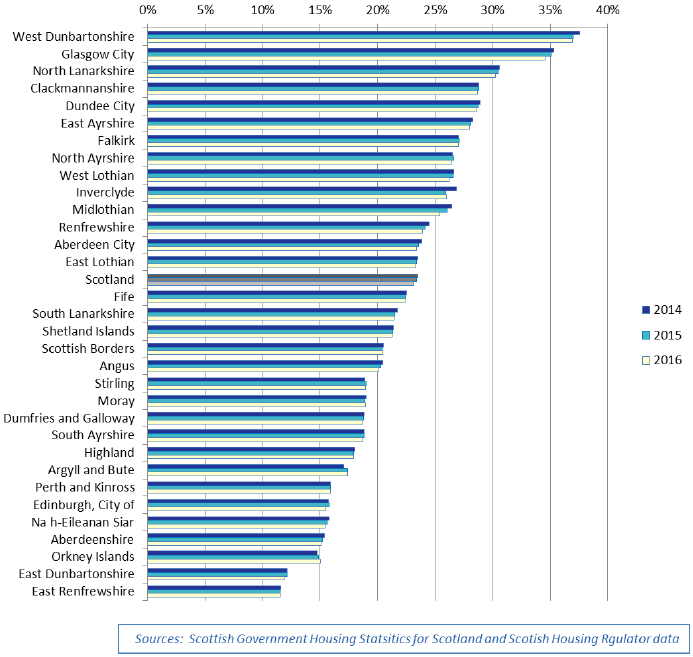
2.3 Stock across all tenures, Scotland, England and Wales
Chart 2.5 and Table 2.5 below show stock across all tenures for Scotland from 2001 to 2016. In 2016 Scotland had a total of 2.57 million dwellings. Social rented housing stock totalled 594 thousand dwellings, 23% of the total. There were 1.58 million owner occupied dwellings (61% of the total) and 394 thousand private rented dwellings (15% of the total).
From 2015 to 2016, the total number of dwellings in Scotland increased by 1% (17,553 homes). The number of social rented properties dropped slightly (a decrease of 594 homes), the number of private rented dwellings increased by 3% (12,093 homes), and the number of owner occupier dwellings increased by 0.4% (5,880 homes).
Over the longer term period from 2001 to 2016, the total number of dwellings in Scotland has increased by 11% (254,757 homes). The number of social rented properties across this time period has fallen by 14% (97,066 homes), whilst the number of private rented dwellings has more than doubled (a 128% increase, or 221,443 homes), and the number of owner occupier dwellings has increased by 9% (130,205 homes).
Chart 2.5: Stock by tenure (thousands of units), Scotland, 2001 to 2016
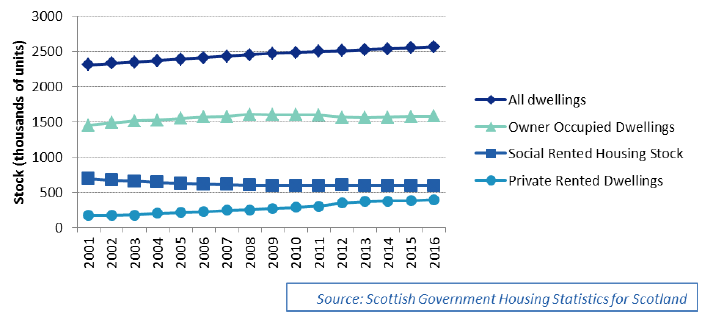
Table 2.5: Stock by tenure, Scotland, 2001 to 2016 (thousands of units)
| All dwellings | Social Rented Housing Stock | Private Rented Dwellings | Owner Occupied Dwellings | Social Rented Housing Stock (%) | Private Rented Dwellings (%) | Owner Occupied Dwellings (%) | |
|---|---|---|---|---|---|---|---|
| 2001 | 2,312 | 692 | 173 | 1,448 | 30% | 7% | 63% |
| 2002 | 2,329 | 674 | 171 | 1,485 | 29% | 7% | 64% |
| 2003 | 2,347 | 655 | 179 | 1,513 | 28% | 8% | 64% |
| 2004 | 2,367 | 640 | 203 | 1,523 | 27% | 9% | 64% |
| 2005 | 2,387 | 626 | 215 | 1,546 | 26% | 9% | 65% |
| 2006 | 2,406 | 613 | 224 | 1,569 | 25% | 9% | 65% |
| 2007 | 2,428 | 607 | 247 | 1,574 | 25% | 10% | 65% |
| 2008 | 2,451 | 599 | 248 | 1,604 | 24% | 10% | 65% |
| 2009 | 2,469 | 594 | 272 | 1,603 | 24% | 11% | 65% |
| 2010 | 2,482 | 596 | 288 | 1,599 | 24% | 12% | 64% |
| 2011 | 2,495 | 595 | 304 | 1,596 | 24% | 12% | 64% |
| 2012 | 2,508 | 597 | 347 | 1,564 | 24% | 14% | 62% |
| 2013 | 2,521 | 596 | 368 | 1,557 | 24% | 15% | 62% |
| 2014 | 2,534 | 595 | 375 | 1,565 | 23% | 15% | 62% |
| 2015 | 2,549 | 595 | 382 | 1,572 | 23% | 15% | 62% |
| 2016 | 2,567 | 594 | 394 | 1,578 | 23% | 15% | 61% |
| change from 2015 to 2016: | |||||||
| change (%) | 1% | 0% | 3% | 0% | |||
| change (thousands of units) | 17.6 | -0.6 | 12.1 | 5.9 | |||
| change from 2001 to 2016 | |||||||
| change (%) | 11% | -14% | 128% | 9% | |||
| change (thousands of units) | 254.8 | -97.1 | 221.4 | 130.2 | |||
Source: Scottish Government Housing Statistics for Scotland
Note: Private Rented includes accommodation tied to employment and others living rent free. Vacant private dwellings have been apportioned to the owner occupied category
Chart 2.6 below shows stock by tenure as a percentage of all dwellings in 2016 for Scotland, England and Wales. It can be seen that Scotland had the highest proportion of social renting stock (23%) compared to both England (17%) and Wales (16%). England had the highest proportion of private rented dwellings (20%), compared to Scotland (15%) and Wales (14%), whilst Wales had the highest proportion of owner occupier dwellings (70%) compared to both Scotland (61%) and England (62%).
Chart 2.6: Stock by tenure as a percentage of all dwellings in 2016 - Scotland, England, Wales

Charts 2.7 and 2.8 and Tables 2.6 and 2.7 below provide further detail on changes to stock by tenure for England and Wales. From these, along with the equivalent figures for Scotland, it can be seen that there have been similar increases in the total number of dwellings over the 2001 to 2016 time period in Scotland, England and Wales (11%, 12%, and 11%, respectively).
Social rented stock fell by 14% in Scotland between 2001 and 2016, a higher proportion than the equivalent figures for England (a 6% drop) and Wales (an 8% drop).
Each country has seen the number of private rented dwellings more than doubling between 2001 and 2016, with increases being 128% in Scotland, 127% in England and 124% in Wales.
The number of owner occupier dwellings in Scotland in 2016 was 9% higher when compared to the numbers in 2001. Wales saw a 5% increase between these two years whilst England saw little change.
Chart 2.7: Stock by tenure (thousands of units), England, 2001 to 2016
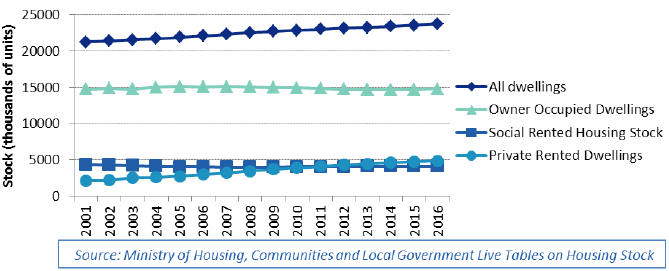
Table 2.6: Stock by tenure, England 2001 to 2016 (thousands of units)
| All dwellings | Social Rented Housing Stock | Private Rented Dwellings | Owner Occupied Dwellings | Social Rented Housing Stock (%) | Private Rented Dwellings (%) | Owner Occupied Dwellings (%) | |
|---|---|---|---|---|---|---|---|
| 2001 | 21,207 | 4,339 | 2,133 | 14,735 | 20% | 10% | 69% |
| 2002 | 21,354 | 4,310 | 2,197 | 14,846 | 20% | 10% | 70% |
| 2003 | 21,513 | 4,212 | 2,549 | 14,752 | 20% | 12% | 69% |
| 2004 | 21,684 | 4,120 | 2,578 | 14,986 | 19% | 12% | 69% |
| 2005 | 21,870 | 4,050 | 2,720 | 15,100 | 19% | 12% | 69% |
| 2006 | 22,073 | 4,034 | 2,987 | 15,052 | 18% | 14% | 68% |
| 2007 | 22,288 | 4,013 | 3,182 | 15,093 | 18% | 14% | 68% |
| 2008 | 22,511 | 4,000 | 3,443 | 15,067 | 18% | 15% | 67% |
| 2009 | 22,694 | 4,022 | 3,705 | 14,968 | 18% | 16% | 66% |
| 2010 | 22,839 | 4,032 | 3,912 | 14,895 | 18% | 17% | 65% |
| 2011 | 22,976 | 4,044 | 4,105 | 14,827 | 18% | 18% | 65% |
| 2012 | 23,111 | 4,072 | 4,286 | 14,754 | 18% | 19% | 64% |
| 2013 | 23,236 | 4,086 | 4,465 | 14,685 | 18% | 19% | 63% |
| 2014 | 23,372 | 4,076 | 4,623 | 14,674 | 17% | 20% | 63% |
| 2015 | 23,543 | 4,085 | 4,773 | 14,684 | 17% | 20% | 62% |
| 2016 | 23,733 | 4,099 | 4,847 | 14,786 | 17% | 20% | 62% |
| change from 2015 to 2016 | 1% | 0% | 2% | 1% | |||
| change from 2001 to 2016 | 12% | -6% | 127% | 0% | |||
Source: Ministry of Housing, Communities and Local Government Live Tables on Housing Stock
Chart 2.8: Stock by tenure (thousands of units), Wales, 2001 to 2016
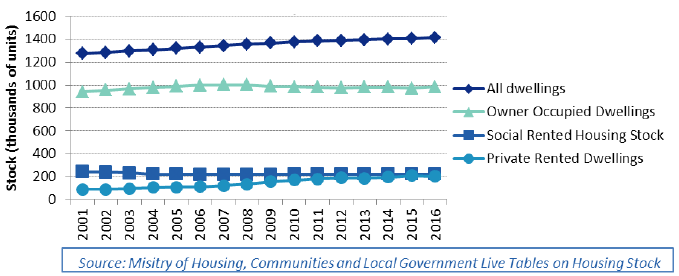
Table 2.7: Stock by tenure, Wales 2001 to 2016 (thousands of units)
| All dwellings | Social Rented Housing Stock | Private Rented Dwellings | Owner Occupied Dwellings | Social Rented Housing Stock (%) | Private Rented Dwellings (%) | Owner Occupied Dwellings (%) | |
|---|---|---|---|---|---|---|---|
| 2001 | 1,275 | 243 | 90 | 941 | 19% | 7% | 74% |
| 2002 | 1,285 | 240 | 89 | 957 | 19% | 7% | 74% |
| 2003 | 1,296 | 233 | 97 | 966 | 18% | 7% | 75% |
| 2004 | 1,307 | 224 | 104 | 979 | 17% | 8% | 75% |
| 2005 | 1,319 | 221 | 109 | 989 | 17% | 8% | 75% |
| 2006 | 1,331 | 220 | 113 | 997 | 17% | 8% | 75% |
| 2007 | 1,343 | 220 | 122 | 1,002 | 16% | 9% | 75% |
| 2008 | 1,355 | 219 | 135 | 1,001 | 16% | 10% | 74% |
| 2009 | 1,366 | 220 | 157 | 989 | 16% | 11% | 72% |
| 2010 | 1,375 | 221 | 170 | 984 | 16% | 12% | 72% |
| 2011 | 1,384 | 223 | 180 | 981 | 16% | 13% | 71% |
| 2012 | 1,389 | 223 | 189 | 977 | 16% | 14% | 70% |
| 2013 | 1,394 | 223 | 188 | 983 | 16% | 13% | 71% |
| 2014 | 1,400 | 223 | 196 | 981 | 16% | 14% | 70% |
| 2015 | 1,406 | 224 | 208 | 974 | 16% | 15% | 69% |
| 2016 | 1,413 | 224 | 202 | 986 | 16% | 14% | 70% |
| change from 2015 to 2016 | 0% | 0% | -3% | 1% | |||
| change from 2001 to 2016 | 11% | -8% | 124% | 5% | |||
Source: Ministry of Housing, Communities and Local Government Live Tables on Housing Stock
2.4 Types of dwellings (houses/flats)
Based on households interviewed as part of the Scottish Household Survey, 43% of social rented households in Scotland in 2016 were living in a house, a similar level to the 42% figure in 1999. Correspondingly, 57% of households were living in a flat in 2016, a similar level to 58% in 1999.
Chart 2.9: Dwelling type of social rented households, 1999, 2007 and 2016

There were some differences in dwelling types between social landlord providers in 2016, with 48% of local authority households living in houses and 52% living in flats, whilst only 37% of housing association households were living in a house and 63% living in a flat, however some of this difference may be due to the large proportion of flatted properties in Glasgow, a stock transfer authority in which all social stock is owned by housing associations.
Chart 2.10: Dwelling type of social rented households 2016, by social rented landlord
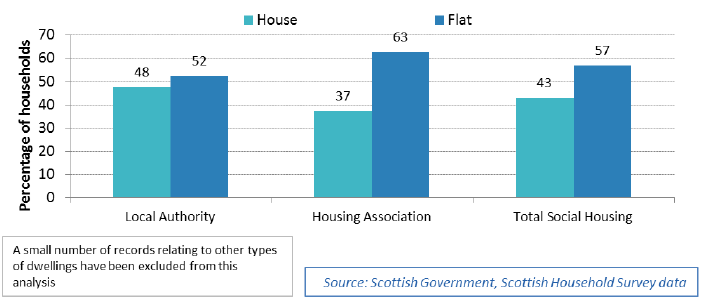
Chart 2.11 presents estimates of dwelling types of social rented households by individual local authority areas. Data for the four years from 2013 to 2016 has been combined together to provide a sufficient sample size to allow a local authority analysis to be produced. However, due to the range of sample sizes across the local authorities, there will be larger margins of error for some local authorities than others, and as such some differences between local authorities should be treated with caution, as these might reflect sampling variation rather than real changes.
As shown in Chart 2.11, city authorities tend to have more social housing flats than houses (Glasgow City 81%, City of Edinburgh 80%, Aberdeen City 75% and Dundee City 71%), whereas more rural authorities have fewer flats (Orkney Islands 16%, Na h-Eileanan Siar 19%, Shetland Islands 21% and Highlands 23%).
Chart 2.11: Dwelling type of social rented households, 2013 to 2016, by local authority
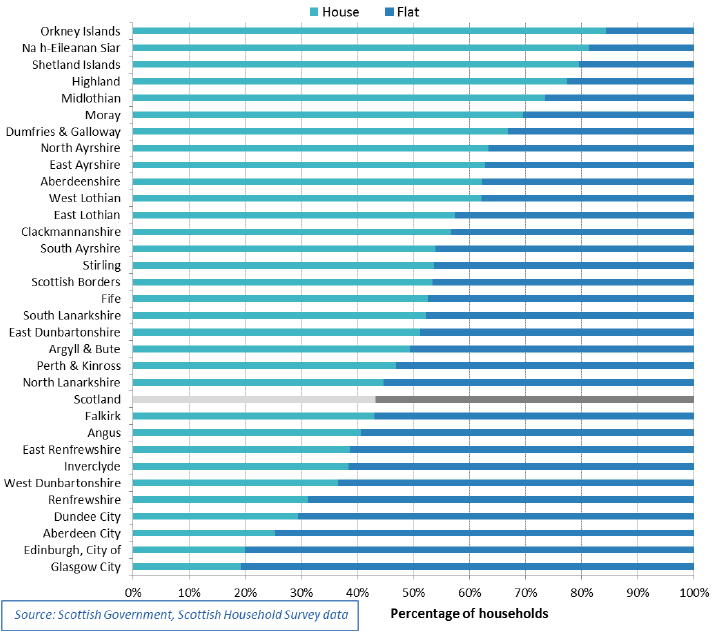
Note: survey data from the four years from 2013 to 2016 has been combined together to provide a sufficient sample size to allow a local authority level analysis. However local authority sample sizes across these four years vary from 100 in East Renfrewshire up to 1,260 in Glasgow City, and so there will be larger margins of error for some local authorities than others, and as such some differences between local authorities should be treated with caution, as these might reflect sampling variation rather than real changes.
In 2016, 33% of private rented households were living in houses, a similar proportion to housing association households. Owner occupied households were much more likely to be living in houses, with 78% of households buying with a mortgage living in a house and 83% of households who own outright living in a house.
Chart 2.12: Dwelling type of households 2016, by tenure
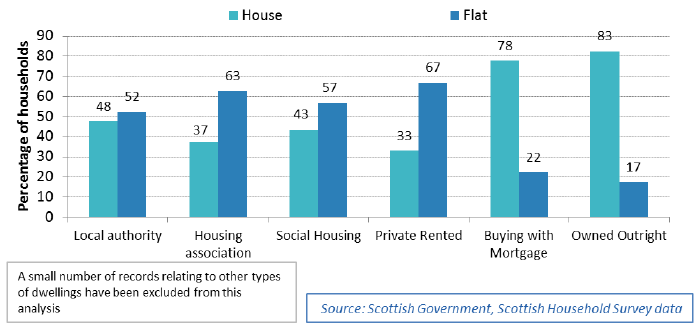
When looking solely at social rented households in which an adult had moved into the property within the last 12 months (which includes new-lets as well as changes to existing household compositions), 49% of local authority and 36% of housing association households were living in a house in 2013 to 2016, figures which are similar to those for all social households in 2016. This would suggest that newly formed social rented households are living in dwelling types (houses/flats) that are similar to more established social households.
Chart 2.13: Dwelling type of social rented households , 2013 to 2016, where an adult has moved into the address within the last 12 months

2.5 Number of bedrooms
Based on responses from households interviewed for the Scottish Household Survey, dwellings occupied by social rented households in 2016 contained an average of 2.0 bedrooms, similar to the average of 2.1 bedrooms per dwelling in 1999.
The most common size of social rented dwelling in 2016 was 2 bedrooms, with 47% of dwellings being this size, a similar level to 1999 (45%). In 2016, 27% of social rented dwellings contained 1 bedroom, a slight increase from 25% in 1999, whilst 23% of dwellings contained 3 bedrooms, a drop from 27% in 1999.
Chart 2.14: Number of bedrooms in social rented dwellings, 1999, 2007 and 2016

There were similar values for average numbers of bedrooms between social landlord providers in 2016, with local authority dwellings on average containing 2.1 bedrooms compared with 2.0 for housing association dwellings.
Chart 2.15: Number of bedrooms in social rented dwellings, 2016, by social landlord

Within the four years 2013 to 2016, the percentage of social rented properties with only one bedroom varied from 13% in Midlothian up to 40% in Aberdeenshire and 41% in the Orkney Islands. This compared to 29% across Scotland as a whole. The percentage of properties with three or more bedrooms varied from 17% in Aberdeen City and 18% in Angus and Dundee City up to 42% in the Shetland Islands and 45% in West Lothian.
Chart 2.16: Number of bedrooms in social rented dwellings, 2013 to 2016, by local authority

Note: survey data from the four years from 2013 to 2016 has been combined together to provide a sufficient sample size to allow a local authority level analysis. However local authority sample sizes across these four years vary from 100 in East Renfrewshire up to 1,260 in Glasgow City, and so there will be larger margins of error for some local authorities than others, and as such some differences between local authorities should be treated with caution, as these might reflect sampling variation rather than real changes.
There were some differences in the numbers of bedrooms in dwellings in 2016 by tenure, with social rented dwellings having the smallest average size of 2.0 bedrooms. This compared to an average size of 2.2 bedrooms in private rented dwellings, 2.9 bedrooms in dwellings being bought with a mortgage and 2.9 bedrooms in dwellings owned outright.
Dwellings being bought with a mortgage and owned outright were much more likely to have 4 or more bedrooms (26% and 20% respectively).
Chart 2.17: Number of bedrooms of dwellings, 2016, by tenure
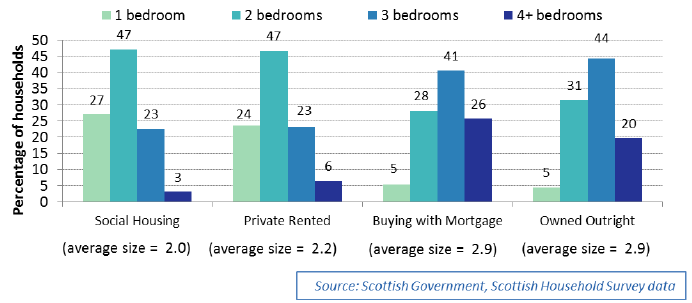
When looking solely at social rented households in which an adult had moved into the property within the last 12 months (which includes new-lets as well as changes to existing household compositions), the number of bedrooms in these dwellings have been similar to the figures for all social rented dwellings. Dwellings occupied by households where an adult had moved into the address within the last 12 months in 2013 to 2016 had on average 2.0 bedrooms. This is the same as the figure of 2.0 bedrooms of all social rented dwellings in 2016. This would suggest that newly formed social rented households are on average living in dwellings with a similar number of bedrooms to more established social households.
Chart 2.18: Number of bedrooms of social rented dwellings, where an adult has moved into the address within the last 12 months
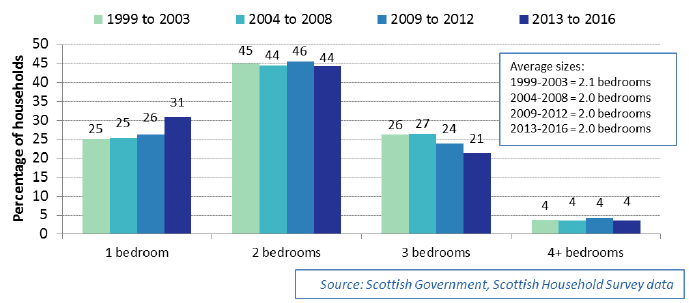
2.6 Location of households in Areas of Multiple Deprivation
The Scottish Index of Multiple Deprivation ( SIMD [6] ) is a Scottish Government statistical tool for identifying places in Scotland suffering from deprivation. It incorporates several different aspects of deprivation, combining them into a single index. It divides Scotland into small areas and provides a relative ranking for each area from most deprived to least deprived.
Based on the location of households interviewed for the Scottish Household Survey, 46% of social rented households in 2016 were living in dwellings in the 20% most deprived areas of Scotland (as defined by the SIMD 2012 measure), a similar proportion to the years 2012 to 2015. Only 2% were living in the 20% least deprived areas of the country. The SIMD 2012 measure has been used to enable comparisons to made between these years. When using the most recent measure, SIMD 2016, 44% of social rented households were living in dwellings in the 20% most deprived areas of Scotland.
Chart 2.19: SIMD location of social rented households, 2012 to 2016
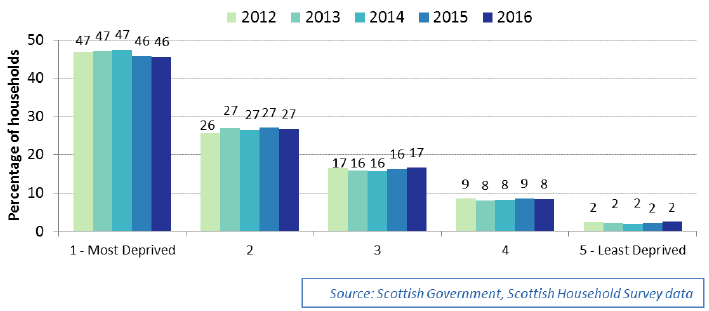
There were some differences in deprivation locations between social landlord providers in 2016, with 55% of housing association households living in dwellings in the 20% most deprived areas, compared to 39% of local authority households. However some of this difference may be due to the number of households located in deprived areas within Glasgow, a stock transfer authority in which all social stock is owned by housing associations.
Chart 2.20: SIMD location of social rented households, 2016, by landord
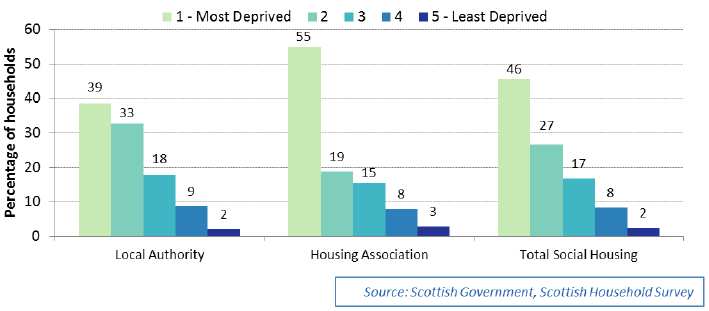
Chart 2.21 below shows the percentage of social rented households in each local authority who live in one of the 20% most deprived areas of Scotland. In Glasgow and Inverclyde, 82% and 80% of social rented households, respectively, live in one of the 20% most deprived areas of the country. In the island local authorities (Shetland, Orkney and Na h-Eileanan Siar) 0% of social rented households lived in one of the 20% most deprived areas of Scotland, however these figures can be explained because none of the areas of these three local authorities have been classed as being in the most 20% deprived areas of Scotland. For SIMD 2012 as a whole, the percentage of datazones in the most 20% deprived areas of the country varies from 0% in Shetland, Orkney and Na h-Eileanan Siar, up to 45% in Inverclyde and 49% in Glasgow.
Chart 2.21: Social rented households living in the 20% most deprived areas of Scotland, 2013 to 2016, by local authority
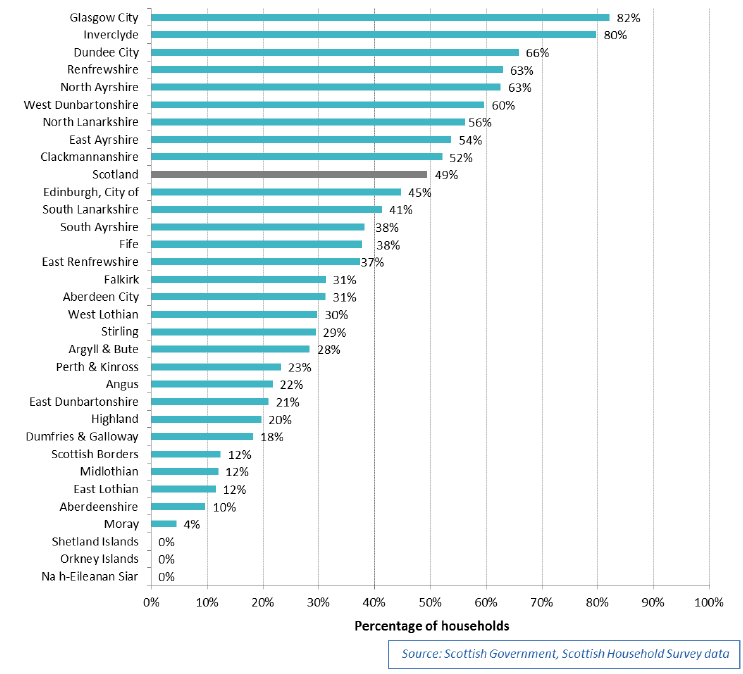
Note: survey data from the four years from 2013 to 2016 has been combined together to provide a sufficient sample size to allow a local authority level analysis. However local authority sample sizes across these four years vary from 100 in East Renfrewshire up to 1,260 in Glasgow City, and so there will be larger margins of error for some local authorities than others, and as such some differences between local authorities should be treated with caution, as these might reflect sampling variation rather than real changes.
There were also differences in deprivation locations between social households and other tenures. In 2016, 46% of social rented households were living in the 20% most deprived areas, compared to 19% of private rented households, 14% of households buying with a mortgage and 11% of households owning outright. Only 2% of social rented households were living in the 20% least deprived areas, which compared to 16% for private rented households, 23% for households buying with a mortgage and 27% of households owning outright.
Chart 2.22: SIMD location of households, 2016, by tenure
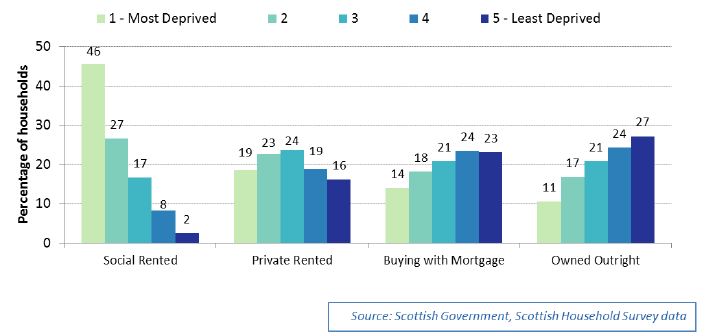
When looking solely at social rented households in which an adult had moved into the property within the last 12 months from 2013 to 2016 (which includes new-lets as well as changes to existing household compositions), 49% of social rented households were living in dwellings in the 20% most deprived areas, which is slightly more than the equivalent figure for all social households in 2016 (46%). This suggests that newly formed social rented households may be slightly more likely to be living in dwellings located in the 20% most deprived areas of the country compared with more established social households.
Chart 2.23: SIMD location of social rented households, 2013 to 2016, where an adult has moved into the address within the last 12 months
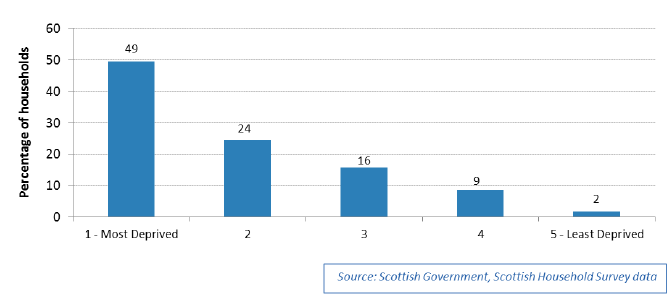
2.7 Location of households in rural or urban areas
The Scottish Government Urban Rural Classification 2013/14 [7] provides a standard definition of urban and rural areas in Scotland.
Based on the location of households interviewed for the Scottish Household Survey in 2016, 27% of local authority households were living in dwellings in large urban areas, compared to 55% of housing association households. Also, 44% of local authority households were living in other (i.e. non-large) urban areas, compared with 27% of housing association households. These differences may be partly explained by stock transfers that have happened, for example all social rented housing in Glasgow is now provided by housing associations, properties which are mostly likely to fall within the large urban area category.
Chart 2.24: Urban Rural location of social rented households, 2016, by landord
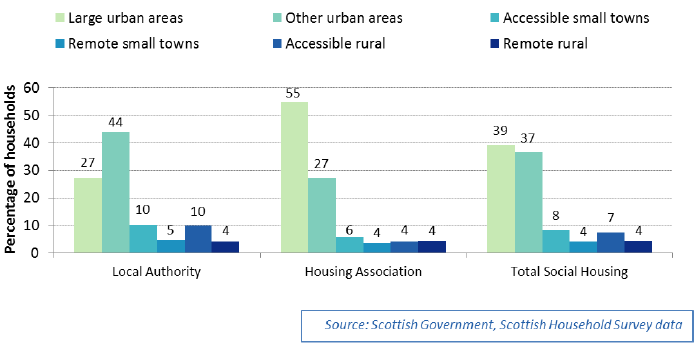
Chart 2.25 below shows the urban rural location of social rented households in each local authority. The six classifications have been combined to make three categories: urban areas (includes large and other urban areas), small towns (includes accessible and remote small towns), and rural areas (includes accessible and remote rural). Based on the location of households interviewed for the Scottish Household Survey between 2013 and 2016, 100% of social rented households in Dundee City, Glasgow City and West Dunbartonshire lived in an urban area. Na h-Eileanan Siar, Orkney and Sheland all had 0% of social rented households living in urban areas, and around half of households living in small towns.
Chart 2.25: Urban Rural location of social rented households, 2013 to 2016, by local authority
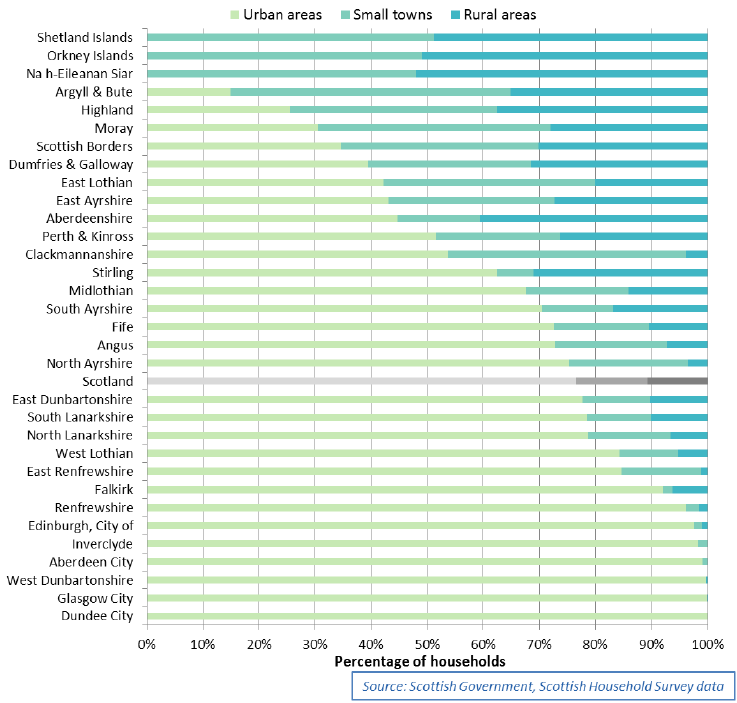
Note: survey data from the four years from 2013 to 2016 has been combined together to provide a sufficient sample size to allow a local authority level analysis. However local authority sample sizes across these four years vary from 100 in East Renfrewshire up to 1,260 in Glasgow City, and so there will be larger margins of error for some local authorities than others, and as such some differences between local authorities should be treated with caution, as these might reflect sampling variation rather than real changes.
The urban rural location of households in 2016 also varied across other tenures, with households buying with a mortgage or owning outright being less likely to live in large urban areas compared to social households.
Chart 2.26: Urban Rural location of households, 2016, by tenure
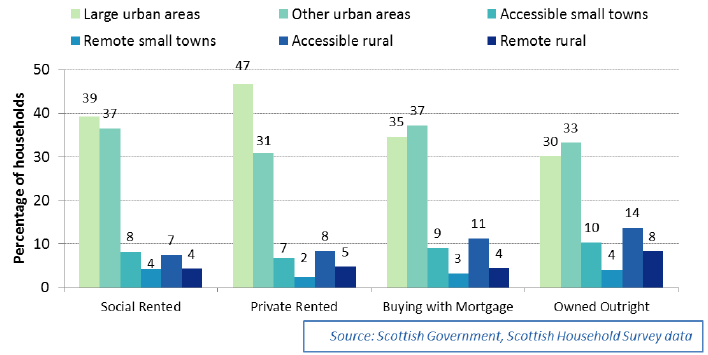
2.8 Scottish Housing Quality Standard
The Scottish House Condition Survey ( SHCS) module of the Scottish Household Survey assesses properties under the Scottish Housing Quality Standard ( SHQS), a common standard for assessing the condition of Scottish housing.
The SHQS target for social housing was incorporated into the Scottish Social Housing Charter and the independent Scottish Housing Regulator ( SHR) is responsible for monitoring landlords’ performance. Latest figures published by the SHR indicate that 93.6% of social homes met the SHQS in 2016/17. This is higher than the compliance rate estimated through the SHCS. Although both sources have shown substantial improvements in quality standards over time, there are some differences in the methods and the timing for collecting the data that account for the difference in headline rates.
In 2016, SHCS results showed that 38% of social rented dwellings failed the SHQS, a decrease from 52% of dwellings in 2012. Local authority properties were more likely to fail the standard (45%) than housing association properties (29%), and social rented dwellings were on average less likely to fail the SHQS (38%) when compared with private housing dwellings (47%).
Table 2.8: Number and proportion of dwellings failing the Scottish Housing Quality Standard ( SHQS), 2012 to 2016
| 2012 | 2013 | 2014 | 2015 (r) | 2016 | ||||||
|---|---|---|---|---|---|---|---|---|---|---|
| % fail | Sample Base | % fail | Sample Base | % fail | Sample Base | % fail | Sample Base | % fail | Sample Base | |
| All Scotland | 54% | 2,787 | 49% | 2,725 | 47% | 2,680 | 45% | 2,754 | 45% | 2,850 |
| Tenure: | ||||||||||
| Owned outright | 57% | 900 | 53% | 880 | 48% | 900 | 48% | 929 | 51% | 988 |
| Owned with a mortgage | 50% | 850 | 47% | 850 | 47% | 790 | 44% | 811 | 40% | 802 |
| Local Authority | 59% | 420 | 51% | 390 | 47% | 390 | 46% | 380 | 45% | 419 |
| Housing Association | 42% | 280 | 33% | 280 | 41% | 290 | 30% | 279 | 29% | 297 |
| Private Rented | 63% | 290 | 55% | 300 | 54% | 320 | 54% | 355 | 53% | 344 |
| All Private | 55% | 2,050 | 51% | 2,020 | 48% | 2,010 | 47% | 2,095 | 47% | 2,134 |
| All Social | 52% | 700 | 43% | 660 | 45% | 670 | 39% | 659 | 38% | 716 |
Source: Scottish House Condition Survey Key Findings
Note that figures in 2014 and 2016 are not fully comparable with previous years.
Percentages for 2015 have been revised since the previous publication.
The most likely reason for social rented properties to fail the SHQS in 2016 was due to not being sufficiently energy efficient (26%). Whilst 9% were assessed as failing due to not being healthy, safe or secure, 8% failed due to lacking modern facilities or services, and 1% failed due to being below tolerable standards.
Table 2.9: Scottish Housing Quality Standard ( SHQS) criteria failure rates by tenure, 2012 to 2016
| 2012 | 2013 | 2014 | 2015 | 2016 | |
|---|---|---|---|---|---|
| All tenures: | |||||
| SHQS Overall | 54% | 49% | 47% | 45% (r) | 45% |
| Below Tolerable Standard | 4% | 3% | 2% | 2% | 2% |
| Serious Disrepair | 0% | 0% | 0% | 0% | 0% |
| Not Energy Efficient | 42% | 36% | 35% | 34% (r) | 33% |
| Lacking Modern Facilities/Services | 12% | 11% | 11% | 9% | 9% |
| Not Healthy, Safe or Secure | 16% | 14% | 14% | 13% | 12% |
| Social: | |||||
| SHQS Overall | 52% | 43% | 45% | 39% (r) | 38% |
| Below Tolerable Standard | 3% | 3% | 1% | 1% | 1% |
| Serious Disrepair | 0% | 0% | 0% | 0% | 0% |
| Not Energy Efficient | 39% | 28% | 30% | 27% (r) | 26% |
| Lacking Modern Facilities/Services | 15% | 12% | 12% | 8% | 8% |
| Not Healthy, Safe or Secure | 13% | 13% | 14% | 10% | 9% |
| Private: | |||||
| SHQS Overall | 55% | 51% | 48% | 47% (r) | 47% |
| Below Tolerable Standard | 4% | 3% | 2% | 2% | 2% |
| Serious Disrepair | 0% | 0% | 0% | 0% | 0% |
| Not Energy Efficient | 43% | 39% | 37% | 36% (r) | 35% |
| Lacking Modern Facilities/Services | 11% | 11% | 11% | 9% | 9% |
| Not Healthy, Safe or Secure | 17% | 14% | 14% | 14% | 14% |
Source: Scottish House Condition Survey Key Findings
Note that figures in 2014 and 2016 are not fully comparable with previous years (r) indicates that percentages have been revised since the previous publication
Contact
There is a problem
Thanks for your feedback